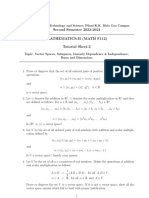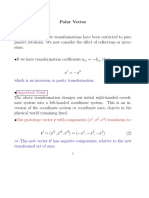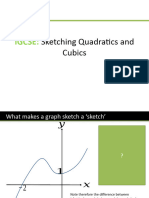MA102 Tutorial2
Uploaded by
Mayyank GargMA102 Tutorial2
Uploaded by
Mayyank GargMA102 Linear Algebra
Tutorial Sheet-2
Second Semester of Academic Year 2017-2018
1. Show that the only possible subspaces of R3 are the zero space {0}, lines passing through
origin, planes passing through origin and whole R3 .
2. Let α1 , α2 , α3 be fixed real numbers. Show that the vectors (x1 , x2 , x3 , x4 ) ∈ R4 such that
x4 = α1 x1 + α2 x2 + α3 x3 form a subspace, which is spanned by (1, 0, 0, α1 ), (0, 1, 0, α2 ) and
(0, 0, 1, α3 ). Find the dimension of this subspace.
3. Let L(S) denote the subspace spanned by a subset S of a vector space V . Prove that if
S ⊆ T ⊆ V and T is a subspace of V , then L(S) ⊆ T . (That is L(S) is the smallest
subspace of V which contains S).
4. Examine whether the following sets of vectors constitute a vector space. If so, find the
dimension and basis of that vector space.
(a) The set of all real functions of the form acosx + bsinx + c, where a, b, c ∈ R.
(b) Homogeneous polynomials in two variables of degree 3 together with zero polynomial.
(c) The set of all n × n real matrices which are : (i) diagonal; (ii) upper triangular; (iii)
trace-zero; (iv) symmetric; (v) anti-symmetric; (vi) invertible; (vii) noninvertible.
(d) The set of all real polynomials of degree 5 together with the zero polynomial.
(e) The set of all complex polynomials of degree ≤ 5 with p(0) = p(1).
(f) The real functions of the form (ax + b)ex , a, b ∈ R.
5. Let Pn (x) denote the vector space consisting of the zero polynomial and all real polynomials
of degree ≤ n, where n is fixed. Check whether the subset S of polynomials is a subspace
of Pn (x) or not, where S is defined by
(a) S = {p(x) ∈ Pn (x) | p(0) = 0}.
(b) S = {p(x) ∈ Pn (x) | p(x) is an odd f unction}.
(c) S = {p(x) ∈ Pn (x) | p(0) = p00 (0) = 0}.
If so, compute the dimension of S.
6. Examine whether the following subsets of the set of real valued functions on R are linearly
dependent or independent. Compute the dimension of the subspace spanned by each set
(a){1 + t, (1 + t)2 } ; (b) {x, |x|}; (c) {1, t, 1 + t2 , (1 + t)2 }.
7. Examine whether the following sets are linearly independent.
(a) {(a, b), (c, d)} ⊂ R2 , with ad − bc 6= 0.
(b) {(1 + i, 2i, 2), (1, 1 + i, 1 − i)} ⊂ C3 .
(c) For α1 , α2 , . . . , αk distinct real numbers, the set {v1 , v2 , . . . vk } ⊂ Rk , where vi =
(1, αi , . . . , αik−1 ).
(d) The set of functions
i. {eα1 x , eα2 x , . . . , eαn x } for distinct real numbers α1 , α2 , . . . , αn .
ii. {1, cosx, cos2x, . . . , cosnx}.
iii. {1, sinx, sin2x, . . . , sinnx}.
iv. {ex , xex , . . . , xn ex }.
8. Let V be a vector space. Let S1 ⊆ S2 ⊆ V .
(a) If S1 is linearly dependent (L.D) then S2 is L.D.
(b) If S2 is linearly independent (L.I) then S1 is L.I.
9. Let S be L.I subset of V and v ∈ V s.t v ∈
/ S, then S ∪ {v} is L.D iff v ∈ span(S).
10. For k = 0, 1, 2, · · · n. Let
Pk (x) = xk + xk+1 + · · · + xn .
Prove that the set {P0 (x), P1 (x), · · · , Pn (x)} is L.I in Pn (R).
11. Let W be a subspace of a finite dim. vector space V . Then dim(W ) < ∞ and dim(W ) ≤
dim(V ). Moreover, dim(W ) = dim(V ) ⇒ V = W .
12. Find the bases for the following subspaces of R5 :
(a) W1 = {(a1 , a2 , a3 , a4 , a5 ) ∈ R5 |a1 − a3 − a4 = 0}.
(b) W2 = {(a1 , a2 , a3 , a4 , a5 ) ∈ R5 |a2 = a3 = a4 , a1 + a5 = 0}.
Also find dim(W1 ) and dim(W2 ).
13. Find conditions on a, b, c so that v = (a, b, c) ∈ R3 belongs to W = span(u1 , u2 , u3 ), where
u1 = (1, 2, 0), u2 = (−1, 1, 2), u3 = (3, 0, −4).
14. State whether the vector space V = P (t), of real polynomials can be spanned by a finite
number of polynomials or not.
15. Let S be a subset of a vector space V. Then prove that
(a) span(S) is a subspace of V containing S.
(b) If W is a subspace of V containing S, then span(S) ⊆ W.
16. Let V be a vector space of 2 × 2 matrices over R. Let W1 and W2 be the subspace of
symmetric and upper-triangular matrices, respectively. Find dim(W1 ) and dim(W2 ) by
finding their bases.
17. Extend the set {(1, 1, 1, 1), (2, 2, 3, 4)} to a basis of R4 .
18. Find the basis and dimension of C over R.
19. Let W be the subspace of R4 spanned by the set {u1 = (1, −2, 5, −3), u2 = (2, 3, 1, −4), u3 =
(3, 8, −3, −5)}
(a) Find a basis and dimension of W.
(b) Extend the basis of W to a basis of R4 .
20. Find a basis and dimension of the subspace W of R3 where:
(a) W = {(a, b, c) ∈ R3 : a + b + c = 0}.
(b) W = {(a, b, c) ∈ R3 : a = b = c}.
You might also like
- Department of Mathematical and Computational Sciences National Institute of Technology Karnataka, SurathkalNo ratings yetDepartment of Mathematical and Computational Sciences National Institute of Technology Karnataka, Surathkal2 pages
- Linear Independence, Basis and Dimension: Dr. A V PrajeeshNo ratings yetLinear Independence, Basis and Dimension: Dr. A V Prajeesh10 pages
- Acharya Nagarjuna University: Linear Algebra and Vector CalculusNo ratings yetAcharya Nagarjuna University: Linear Algebra and Vector Calculus9 pages
- MATH2601-PracticeProblems-Topic 2 Vector SpacesNo ratings yetMATH2601-PracticeProblems-Topic 2 Vector Spaces3 pages
- T1A/T1B, Hmcheungae Math 2121 Tutorial 8 November 1, 2018No ratings yetT1A/T1B, Hmcheungae Math 2121 Tutorial 8 November 1, 20189 pages
- Minor Test 1::: MTL 101::: February 2017No ratings yetMinor Test 1::: MTL 101::: February 20171 page
- MATH 423 Linear Algebra II Review For Test 1No ratings yetMATH 423 Linear Algebra II Review For Test 118 pages
- Exercise: 0 ∈ W u, v ∈ W implies u + v ∈ W u ∈ W, α ∈ F implies αu ∈ WNo ratings yetExercise: 0 ∈ W u, v ∈ W implies u + v ∈ W u ∈ W, α ∈ F implies αu ∈ W12 pages
- Financial Accounting End Term Project: NestleNo ratings yetFinancial Accounting End Term Project: Nestle26 pages
- A Minimalist Flocking Algorithm For Swarm Robots PDFNo ratings yetA Minimalist Flocking Algorithm For Swarm Robots PDF8 pages
- Comparable Company Analysis Template: Strictly ConfidentialNo ratings yetComparable Company Analysis Template: Strictly Confidential3 pages
- CBSE Class X 2010: FRENCH: Answer Key / Correct Responses OnNo ratings yetCBSE Class X 2010: FRENCH: Answer Key / Correct Responses On8 pages
- Instructors Solutions Manual For Elementary Linear Algebra With Applications 9th Edition Ebook PDFNo ratings yetInstructors Solutions Manual For Elementary Linear Algebra With Applications 9th Edition Ebook PDF89 pages
- Weekly Home Learning Plan For (: Grade 9 Mariano Ponce Wlas 1 & 2No ratings yetWeekly Home Learning Plan For (: Grade 9 Mariano Ponce Wlas 1 & 23 pages
- Eigenvalue and Eigenvector Analysis of StabilityNo ratings yetEigenvalue and Eigenvector Analysis of Stability30 pages
- Cramer's Rule: Applying Determinants To Solve Systems of Equations 2x2 & 3x3No ratings yetCramer's Rule: Applying Determinants To Solve Systems of Equations 2x2 & 3x319 pages
- Algebra of Functions Composition SymmetryNo ratings yetAlgebra of Functions Composition Symmetry9 pages
- Study Guide: Eigenvalues, Eigenvectors, and DiagonalizationNo ratings yetStudy Guide: Eigenvalues, Eigenvectors, and Diagonalization2 pages
- C01 Calculus of One Variable - T1 - 1112No ratings yetC01 Calculus of One Variable - T1 - 111251 pages
- Linear Algebraic Groups and Their Lie AlgebrasNo ratings yetLinear Algebraic Groups and Their Lie Algebras81 pages
- E Inf Lim E Sup Lim E: Probability and Statistics Test Set 1No ratings yetE Inf Lim E Sup Lim E: Probability and Statistics Test Set 11 page
- Assignment Grade: X Subject: Mathematics Topic: Quadratic EquationsNo ratings yetAssignment Grade: X Subject: Mathematics Topic: Quadratic Equations2 pages
- Class X: Polynomial: Alfa Circle Contact No:-9621645520No ratings yetClass X: Polynomial: Alfa Circle Contact No:-96216455201 page
- ACHS Math Team Lecture: Pascal's Triangle and The Binomial Theorem Peter S. SimonNo ratings yetACHS Math Team Lecture: Pascal's Triangle and The Binomial Theorem Peter S. Simon21 pages
- Applications of The Duality Method To Generalizations of The Jordan Canonical Form - Olga HoltzNo ratings yetApplications of The Duality Method To Generalizations of The Jordan Canonical Form - Olga Holtz7 pages
- Basis Representation Fundamentals: Notes by J. RombergNo ratings yetBasis Representation Fundamentals: Notes by J. Romberg28 pages
- SPM Trial 2014 Addmaths Qa SBP ScorePerfectNo ratings yetSPM Trial 2014 Addmaths Qa SBP ScorePerfect83 pages









































































































